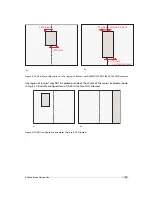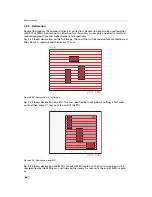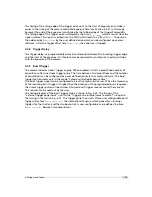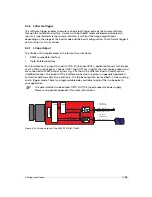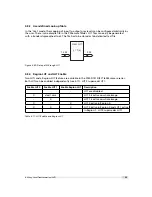
4 Functionality
camera environment to allow robust integration of the camera into the vision system. In the
signal isolator the trigger signal is delayed by time t
d
−
iso
−
input
. This signal is clocked into the
FPGA which leads to a jitter of t
jitter
. The pulse can be delayed by the time t
trigger
−
delay
which
can be configured by a user defined value via camera software. The trigger offset delay
t
trigger
−
offset
results then from the synchronous design of the FPGA state machines. The
exposure time t
exposure
is controlled with an internal exposure time controller.
The trigger pulse from the internal camera control starts also the strobe control state machines.
The strobe can be delayed by t
strobe
−
delay
with an internal counter which can be controlled by
the customer via software settings. The strobe offset delay t
strobe
−
delay
results then from the
synchronous design of the FPGA state machines. A second counter determines the strobe
duration t
strobe
−
duration
(strobe-duration). For a robust system design the strobe output is also
isolated from the camera electronic which leads to an additional delay of t
d
−
iso
−
output
. Table
4.8 and Table 4.9 gives an overview over the minimum and maximum values of the parameters.
External Trigger with Pulsewidth controlled Exposure Time
In the external trigger mode with Pulsewidth controlled exposure time the rising edge of the
trigger pulse starts the camera states machine, which controls the sensor. The falling edge of
the trigger pulse stops the image acquisition. Additionally the optional external strobe output
is controlled by the rising edge of the trigger pulse. Timing diagram Fig. 4.31 shows the
detailed timing for the external trigger mode with pulse width controlled exposure time.
e x t e r n a l t r i g g e r p u l s e i n p u t
t r i g g e r a f t e r i s o l a t o r
t r i g g e r p u l s e r i s i n g e d g e c a m e r a c o n t r o l
d e l a y e d t r i g g e r r i s i n g e d g e f o r s h u t t e r s e t
i n t e r n a l s h u t t e r c o n t r o l
d e l a y e d t r i g g e r f o r s t r o b e c o n t r o l
i n t e r n a l s t r o b e c o n t r o l
e x t e r n a l s t r o b e p u l s e o u t p u t
t
d - i s o - i n p u t
t
j i t t e r
t
t r i g g e r - d e l a y
t
e x p o s u r e
t
s t r o b e - d e l a y
t
d - i s o - o u t p u t
t
s t r o b e - d u r a t i o n
t r i g g e r p u l s e f a l l i n g e d g e c a m e r a c o n t r o l
d e l a y e d t r i g g e r f a l l i n g e d g e s h u t t e r r e s e t
t
j i t t e r
t
t r i g g e r - d e l a y
t
e x p o s u r e
t
t r i g g e r - o f f s e t
t
s t r o b e - o f f s e t
Figure 4.31: Timing diagram for the Pulsewidth controlled exposure time
50
Summary of Contents for SM2-D1312-TI6455
Page 1: ...User Manual SM2 D1312 TI6455 VisionCam PS CMOS DSP Camera MAN060 05 2013 V1 0...
Page 2: ......
Page 4: ...2...
Page 8: ...CONTENTS 6...
Page 48: ...4 Functionality Figure 4 28 Example of decimation 2 on image of injection needle 46...
Page 80: ...4 Functionality 78...
Page 110: ...6 Framework Functionalities 108...
Page 116: ...8 Warranty 114...
Page 118: ...9 References 116...
Page 122: ...A Pinouts 120...
Page 123: ...B Revision History Rev 1 0 May 2013 First version 121...


